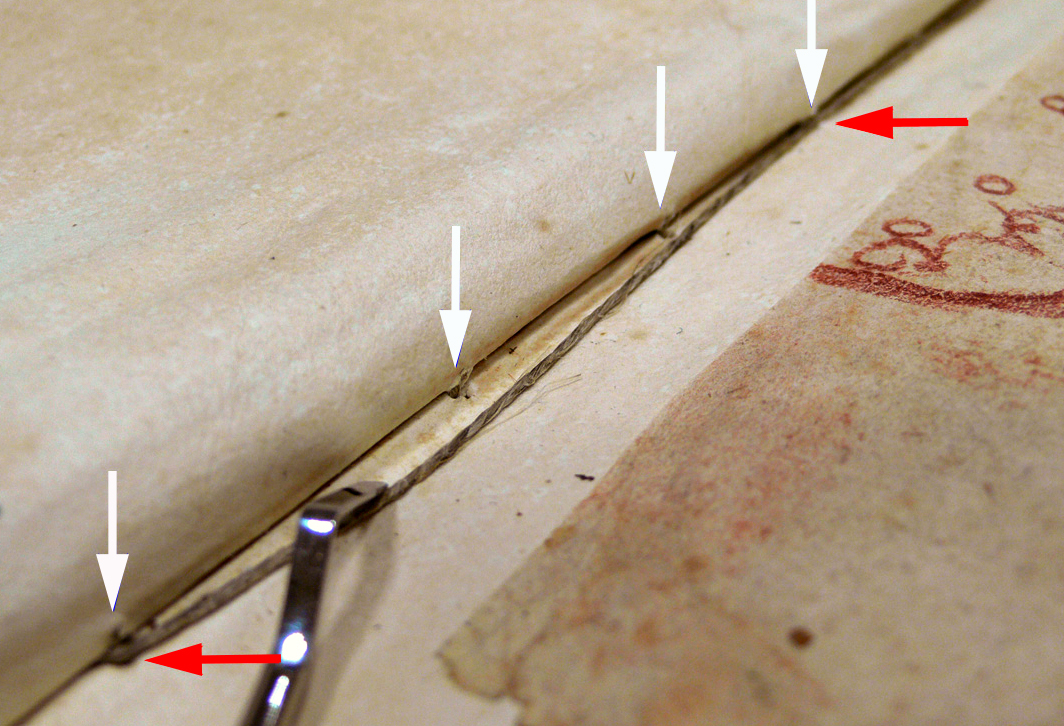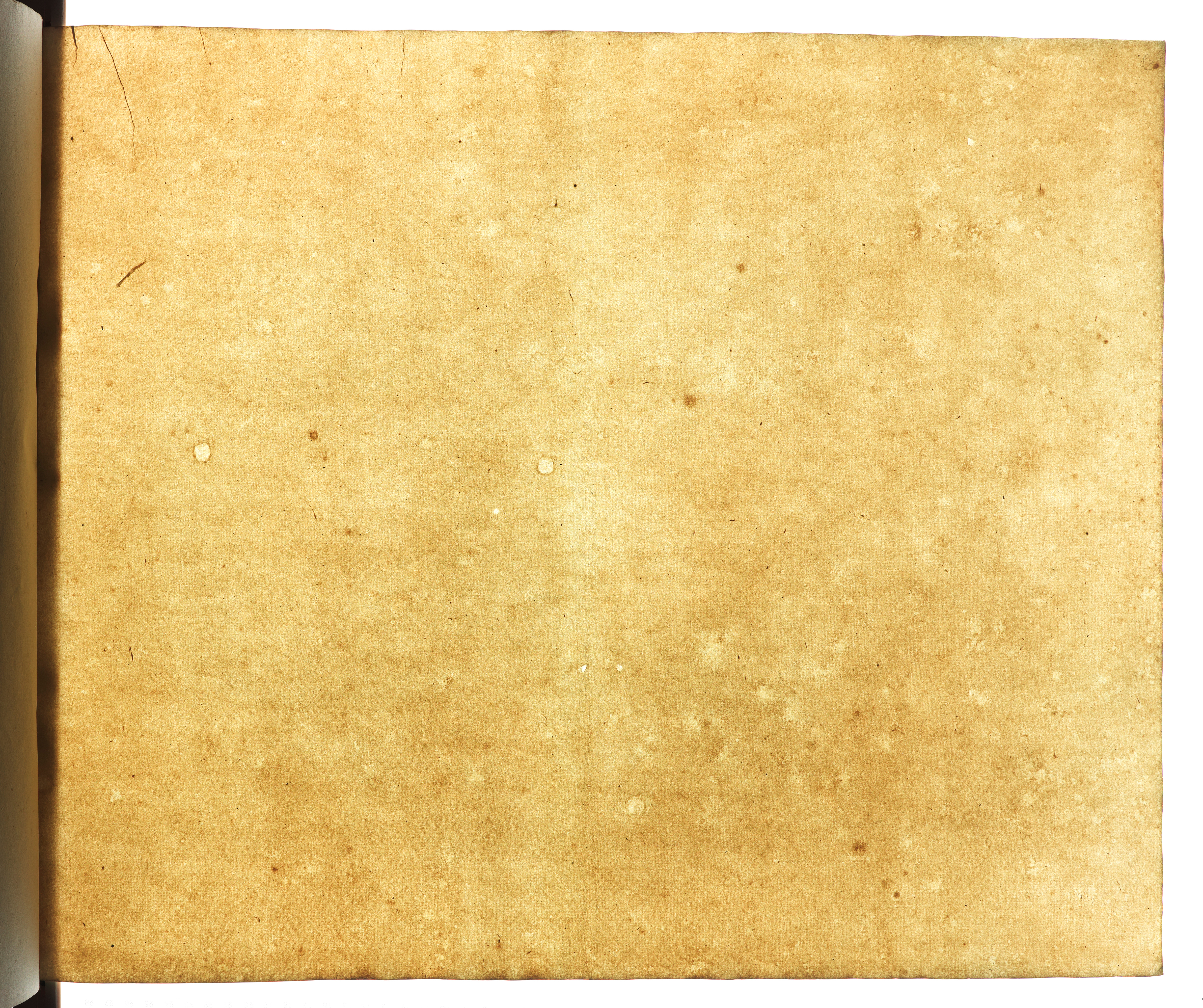
The Structure of the Karlsruhe Piranesi Albums
Judith Becker, Maria Krämer, Irene BrückleAn art technological examination of the albums provides information about the use and history of the two albums.
Explanations
The two half leather bound albums in landscape format are almost identical (Album 1, cover and Album 2, cover ). The covers are made of cardboard, which is approximately 5 mm thick, and the corners of the boards and the tight back, rounded spine are covered in light brown sheep leather with dark marbeling.[1]
Each board is covered in a blue and red marbled paper[2] (Figs. 1 and 2), which is in four sections. It is possible that here remnants supplemented complete sheets of paper. Such piecing together of paper coverings is also known from other large-format volumes, for example, from items in the Nicolai Collection of the Württemberg State Library in Stuttgart, a collection of eighteenth century bindings. The only ornamentation on the otherwise plain album bindings are blind embossed lines running parallel to the spines, which is a characterstic embellishment used in the eighteenth and nineteenth centuries.
The bindings display typical signs of use. The edges of the boards and the corners are bumped, the leather scuffed, and parts of the surface of the marbled paper have suffered abrasion damage during pre-museum use; presumably by pulling or pushing the albums on a shelf or across tables.
 |  |
The book blocks are made of wove paper, now brownish in colour, the individual sheets of which are signatures sewn on five raised cords. Album 1 contains 95 sheets, and Album 2 97 sheets. The signatures mainly consist of eight individual sheets. In order to form signatures from these individual sheets, before sewing in the fold area, they were stitched crosswise with block stitching (Fig. 3).[3] Presumably, a simple overlock stitch was used for this, in which the thread is led diagonally across the spine from one stitching hole to the next. Since the signatures formed by this “pre-stitching” do not have a centre fold, stitching was not always done after half of the sheets in a signature, but was often offset by one or two sheets. Between six of these signatures in both albums, there are an equal number of compensating signatures, usually consisting of five or six double folds each (Fig. 4 and stitching diagram Fig. 5). As folded signatures, these were sewn with through stitching in the middle of the centrefold and serve to compensate for the drawings or items that will be pasted onto the pages — thus obviously the two books were already designed by the bookbinder as albums.
The endpapers, consisting of the sheet adhered to the book cover (the pastedown) and the first free page (the flyleaf), are made up of two individual sheets, which were pasted together with a slight overlap in the fold. The flyleaf is adhered narrowly to the first page of the subsequent signature. Thin white endbands, headbands and tailbands, made of cord are adhered to the book block (Fig. 4).
 |  |
 |
The wove paper of the albums’ folios (sheet size approx. 485 × 600 mm) is a brownish-beige colour today. The paper, made predominantly of rag pulp, also contained considerable inclusions of wood. In transmitted light, the fine mould structure of the wove papermaking mould can be seen, and near the edge of the sheet, often truncated and present in two alternative forms, there is the watermark “F. Buhl”. This is the name of the owners of a paper mill in Ettlingen that resumed operations after being damaged during a fire in 1793, one year after Friedrich Weinbrenner left for Italy;[4] it was still producing paper long after his death (Figs 6 and 7). The album pages have only been slightly trimmed; the majority of the sheets are intact: this is indicated by the unfolded, stitched individual sheets and the position of the watermarks. The paper exhibits some typical characteristics of handmade paper, such as cockling at the edges of the sheets, dark wool fibres that were probably transferred from the couching felts used in drying the sheets, as well as “tears” — circular, thin areas where water dripped onto the paper during hand formation and displaced small areas of pulp, plus a slightly irregular distribution of fiber mass towards the edges (Figs. 8 and 9). At the centre of many sheets, the area where the paper was hung to dry after formation and couching can be seen running vertically. Less discoloured than the rest of the sheet, this area appears as a light, narrow strip (Fig. 8).[5][5] Since the paper contains no or little sizing, it was obviously never intended as writing paper. Paper from the mill in Ettlingen was also used by Weinbrenner for printing lithographs (Entwurf von F. Weinbrenner für das Karl Friedrich-Denkmal in Karlsruhe, gedruckt von Karl Müller, vermutlich 1814, Staatliche Kunsthalle Karlsruhe [design by F. Weinbrenner for the Karl Friedrich monument in Karlsruhe, printed by Karl Müller, probably 1814], Staatliche Kunsthalle Karlsruhe, Inv. X 1876).
 |  |
 |  |
On the aged, slightly brownish album pages, further colour changes are evident, which are spots of adhesive from the Weinbrenner period; either on the front side of the sheet or where the back side came into contact with the drawings mounted on the following page. The drawings themselves, however, do not exhibit any visible changes attributable to contact with the album paper. This can be seen from the folded drawings that were mounted, which only partially came into contact with the album paper page opposite (see, for example, the Newdigate Candelabrum. A major reason for the different aging of the drawing and album papers is the difference in their quality. For all the drawings, paper was used which — despite the variances among them — clearly stands out as superior to the Ettlingen mill paper. The visibly inferior composition of this paper is likely to have been a determining factor in the discoloration of the album sheets, as well as the absence of gelatine sizing to protect the surface,[6] from which the vast majority of the papers of the drawings benefitted, and which were of far higher quality in terms of material. The changes in colour of the album papers can be illustrated by a particularly prominent example of two successive pages (Album 1, sheets 33 and 34) that are representative of many other sheets. Spots of adhesive applied to the front of Album 1 sheet 33 (Fig. 10) have a shielding effect that extends to the back of the sheet and protects it from discoloration, with the result that in these places the paper is still relatively light today (Fig. 11, roundish lighter spots). The effects of different media used for the drawings on the discoloration of the album paper varies. For example, it is relatively light (Fig. 11, marked in red) where the strokes of a drawing in iron gall ink (Fig. 12, marked in red) present on the following sheet 34 were in direct contact in the closed album with sheet 33v. Contact with a drawing in black crayon with a fatty binder (Fig. 12, marked in blue) resulted in a dark discoloration that conform to the strokes of the drawing (Fig. 11, marked in blue).



All album pages are foliated — assigned page numbers — in the right margin. In a few cases, the numbering was written on the mounted drawings after they had been pasted into the album.
In the Archive for Architecture and Engineering (SAAI) at the Karlsruhe Institute of Technology, two albums by Weinbrenner’s students have survived;[7] however, none of Weinbrenner’s other albums, apart from the two Piranesi albums, have survived, which would have served as a useful comparison. The students’ albums clearly demonstrate how the two Piranesi albums, which are now in the possession of the Kunsthalle, were used at Weinbrenner’s school of architecture. They contain numerous motifs from the two Piranesi albums, copied in ink or wash on tracing paper. One of the albums even contains a red chalk drawing, which is presumably by Piranesi himself. How this got into the student’s album is unclear. Since the two Piranesi albums show no evidence of drawings being detached, it is likely that the drawing became separated from the others before they were mounted in the two albums.
Einzelnachweis
1. Bettina Wagner, Außen-Ansichten: Bucheinbände aus 1000 Jahren aus den Beständen der Bayerischen Staatsbibliothek München [Exterior views: Book bindings from 1000 years from the holdings of the Bayerischen Staatsbibliothek in Munich] (Wiesbaden: Harrassowitz Verlag, 2006).
2. Nedim Sönmez, EBRU: Marmorpapiere [Marbled papers] (Ravensburg: Maier, 1992), 92.
3. W. Knees Gnirrep, Johan P. Gumbert, and János A. Szirmai, Kneep en Binding, (The Hague: The Royal Library of the Netherlands, 1992) (accessed 28.8.2021).
4. Frieder Schmidt, “Ettlingen als Standort der deutschen Papierfabrikation” [Ettlingen as location of German paper production], in Festschrift 800 Jahre Stadt Ettlingen, Ettlinger Hefte, Sonderheft 3, 1992, 115–134. Franz Albert Buhl, who died in 1815, had two sons, both with first names beginning with F: Franz Anton (who left the business to his brother in 1842) and Florian. Therefore, it is not possible to identify to which F. Buhl the watermark refers.
5. It is wide and runs straight, unlike the wrinkled appearance of typical drying folds, possibly something other than a rope was used for the drying process.
6. For further relevant literature, see “gelatine” in the Conclusions of a comprehensive study on the state of preservation of historical papers: Timothy Barrett, et al., “Conclusions”, in Paper through Time: Nondestructive Analysis of 14th- through 19th-Century Papers, University of Iowa. Last modified July 1, 2013. (accessed 28. 8. 2021).
7. Karl Joseph Berckmüller, Klebealbum, Archiv für Architektur und Ingenieurbau, Karlsruhe Institut für Technologie (KIT), Karlsruhe, Berckmüller 126; see also Elisabeth Spitzbart, Karl Joseph Berckmüller: 1800–1879, Architekt und Zeichner, Institut für Baugeschichte der Universität Karlsruhe; Wulf Schirmer, ed., Friedrich Weinbrenner und die Weinbrenner-Schule, vol. III, Karlsruhe 1999, 234, cat. no. 170.); Heinrich Geier, Klebealbum (referred to in older literature as Geiersches Skizzenbuch), Archiv für Architektur und Ingenieurbau, KIT, Karlsruhe, Inv. Geier 1.
Our sincere thanks to Georg Kabierske for providing these references to the albums.
GND terms
Permalink | piranesi.kunsthalle-karlsruhe.de/en/essay/3/karlsruhe-klebebaende
The permalink always takes you to the latest version of the article.Citable link | piranesi.kunsthalle-karlsruhe.de/en/essay/3/karlsruhe-klebebaende/1
The quotable link allows you to access this content in the future regardless of any changes made to the text
Comments
This field enables you to leave comments on our objects. These comments will be viewed by our employees and displayed publicly to all readers afterwards.